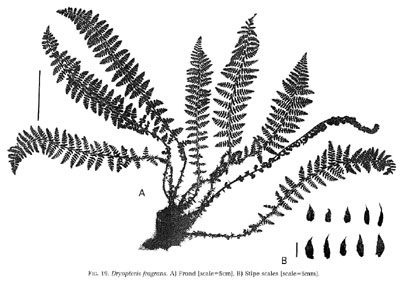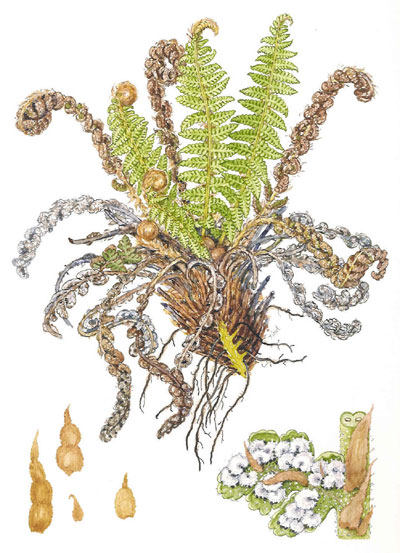| Dryopteris fragrans | ||
Fragrant cliff fern | ||
|
Etymology
Latin: fragrans, fragrant. The fronds have a sweet, fruity odor.
Description
Rhizome: erect, stout.
Frond: 25 cm high by 5 cm wide, persistent old fronds surround the base, monomorphic, blade/stipe ratio: 3:1 to 1:2. Stipe: grooved, scaly, vascular bundles: 6 in a c-shaped pattern. Blade: 2-pinnate-pinnatifid on larger fronds near the rachis, otherwise pinnate-pinnatifid, narrowly elliptic, leathery, upper side bright green, brown to reddish scales below, yellow glandular above (violet or raspberry fragrance). Pinnae: 20 to 30 pair, opposite, sometimes overlapping; pinnules crenately toothed; costae grooved above, continuous from rachis to costae; veins free, forked. Sori: round, medial, indusium: reniform, large, whitish, becoming brown, often overlapping, at a sinus, sporangia: brownish, maturity: midsummer. Culture
Habitat: rock crevices and talus slopes, often calcareous.
Distribution: circumboreal.
Hardy to -40�C, USDA Zone 2, requires a cool summer.
Distinctive Characteristics
mistaken for Woodsia ilvensis, but the persistent, curled, dead fronds are unique
Synonyms
Polypodium fragrans L. Aspidium fragrans Sw. Filix fragrans Farwell Lastrea fragrans Presl Nephrodium fragrans Richards Polystichum fragrans (L.) Roth Thelypteris fragrans Nieuwl. Woodsia xanthosporangia Ching |
|
|

Dryopteris fragrans. The cross-section shape of the stipe at the base changes at the top of the stipe, but the number of vascular bundles remains at six. �Drawing from Ferns of Northeastern United States, Farida A. Wiley, 1936. |

Dryopteris fragrans. �Illustration from The Cultivated Species of the Fern Genus Dryopteris in the United States, Barbara Joe Hoshizaki and Kenneth A. Wilson, American Fern Journal, 89, 1, (1999), with permission. |

Dryopteris fragrans. a)�rhizome, this year's frond and last year's persistent frond; b) portion of fertile pinna. �Illustration by V. Fulford from Ferns and Fern Allies of Canada, William J. Cody and Donald M. Britton, 1989, � Agriculture Canada, used with permission. |
